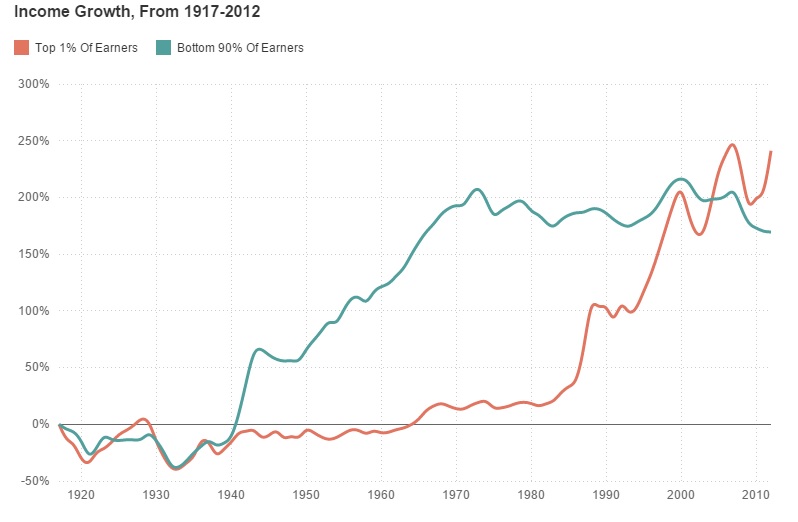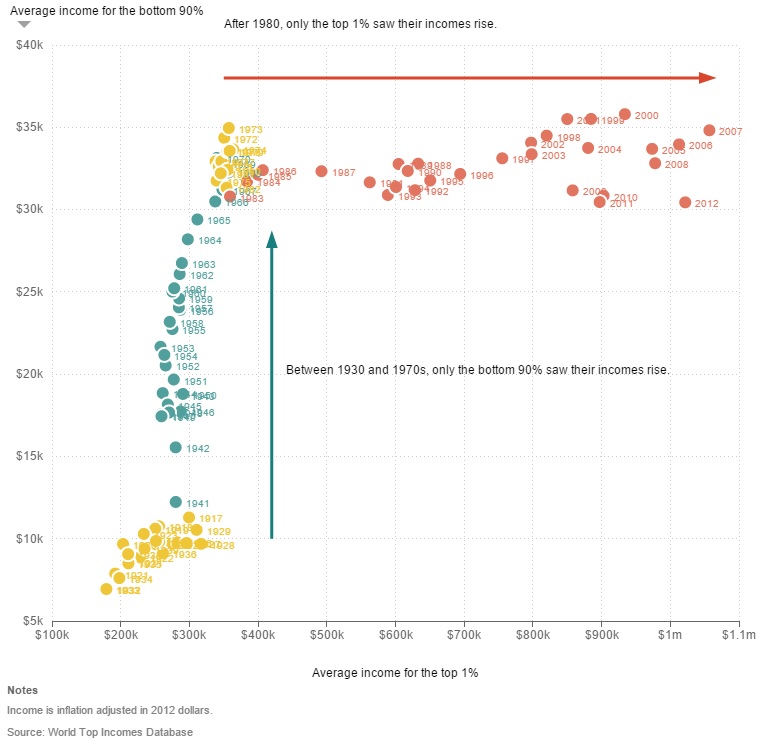Income Inequality in America
NPR put out some great images on income inequality recently. They describe the history of income inequality in the US in a way you might not have considered. Many statistics are hard to interpret, but these aren’t. At first glance, you might immediately jump to the conclusion that the bottom 90% of income earners have gotten squeezed since 1970. However, if you look at the entire chart, it might put things into a different perspective.
Consider the following:
- The Top 1% had almost no income growth from 1920 to 1980, or 60 years.
- The Bottom 90% had two periods of no income growth for a combined 60 years.
- Both groups had a combined period of 30 years in which their incomes rose.
- In the past 15 years, the combined rate of growth for both groups has been similar with a lot of volatility. In 2004, they were the same.
Are the growth rates of income between the top 1% and the bottom 90% really that different?
These charts say no. They just increase at different intervals.
Here is another chart illustrating the year by year differences. The yellow is when the two groups have highly correlated movements.
Why is there income inequality in the US?
The question of why there is income inequality in the US could take up an entire college textbook and you still might not find the correct answer. There is no way to know. All we can do is speculate based on situations and events that occurred around certain periods of time where the discrepancies happened.
High Marginal Tax Rates
Some economists theorize that the high marginal tax rates between 1936 and 1981 which ranged between 63% and 94% had a dampening effect on income growth of the top 1% income earners. Call me crazy but if I was forced to pay 94% of my income in taxes, I would probably not work very hard. That means if you earned $1 million dollars a year, your net take home would be $60,000 after tax. For all you accountants reading this, I know the marginal tax rate would not net exactly $60,000, but I don’t have the old tables, so hold your tongue). In 2013, the real (inflation-adjusted) median household income was $51,939. That should put things into perspective.
I would agree that tax rates play a role in income inequality. However, inflation also plays a role.
Effects of taking the US off the gold standard and inflation
It is interesting that the income growth rate for the bottom 90% peaked around mid- to late-1971. This coincides with Nixon taking the US off the gold standard officially in August 1971. This combined with high inflation or stagflation could also account for a muted period in the 1970s until the early 1980s. Inflation is definitely a factor in wealth inequality, but whether it affects income inequality is less certain.
Other factors impacting income earners
 Other economists have proposed that the causes of income inequality are: automation, globalization, wars, monetary and fiscal policies and changes in union membership. While these factors may be reasons why these income changes happened, they pale in comparison to the direct impact of tax rates. Income taxes on individuals didn’t exist prior to 1913. Too bad there are very few people who are still alive today who remember those days. It puts our government’s fiscal policies in a different perspective knowing that our country got by without taxing individuals based on their income.
Other economists have proposed that the causes of income inequality are: automation, globalization, wars, monetary and fiscal policies and changes in union membership. While these factors may be reasons why these income changes happened, they pale in comparison to the direct impact of tax rates. Income taxes on individuals didn’t exist prior to 1913. Too bad there are very few people who are still alive today who remember those days. It puts our government’s fiscal policies in a different perspective knowing that our country got by without taxing individuals based on their income.
There will be a lot of opinions about this topic since it is a bit of a lightning rod. It is easy to claim income inequality based on the past 30 years alone. It is even easier to blame the 1% since they benefit most. It is harder to look past the political hot buttons and see the truth…
For the last 100 years, the top 1% and bottom 90% have grown their income at roughly the same rate. When it comes to income inequality, the top 1% and bottom 90% may not be as different as you might think.
About Innovative Advisory Group: Innovative Advisory Group, LLC (IAG), an independent Registered Investment Advisory Firm, is bringing innovation to the wealth management industry by combining both traditional and alternative investments. IAG is unique in that they have an extensive understanding of the regulatory and financial considerations involved with self-directed IRAs and other retirement accounts. IAG advises clients on traditional investments, such as stocks, bonds, and mutual funds, as well as advising clients on alternative investments. IAG has a value-oriented approach to investing, which integrates specialized investment experience with extensive resources.
For more information, you can visit http://innovativewealth.com
About the author: Kirk Chisholm is a Wealth Manager and Principal at Innovative Advisory Group. His roles at IAG are co-chair of the Investment Committee and Head of the Traditional Investment Risk Management Group. His background and areas of focus are portfolio management and investment analysis in both the traditional and alternative investment markets. He received a BA degree in Economics from Trinity College in Hartford, CT.





